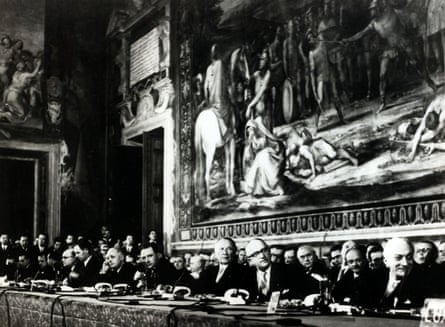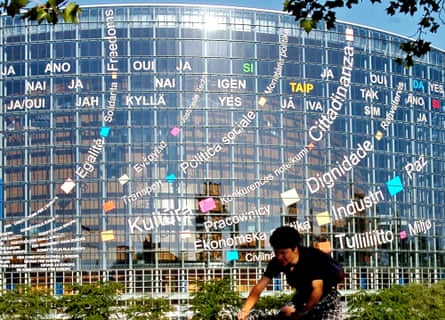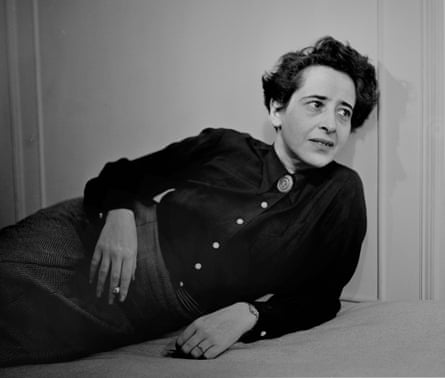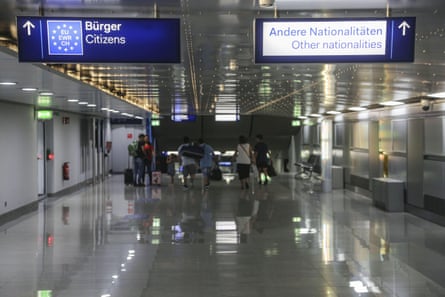‘The Eurocentric fallacy’: the myths that underpin European identity
Many “pro-Europeans” – that is, supporters of European integration or the “European project” in its current form – imagine that the European Union is an expression of cosmopolitanism. They think it stands for diversity, inclusion and openness. It opposes nationalism and racism. It is about people “coming together” and peacefully cooperating. It is a shining example of how enemies can become partners and how diversity can be reconciled with unity.
As the European Commission president José Manuel Barroso put it when the EU was awarded the Nobel Peace prize in 2012 as it struggled to deal with the Eurozone crisis, the European project has shown “that it is possible for peoples and nations to come together across borders” and “that it is possible to overcome the differences between ‘them’ and ‘us’.”
However, there is something rather Eurocentric in thinking of the EU in this way. In particular, by generalising about “peoples and nations” in the way Barroso does, it mistakes Europe for the world. After all, insofar as the European project – that is, the process of European integration since the end of the second world war – has brought people and nations together, it is of course only peoples and nations within Europe. It was a process that began with six western European countries in the immediate postwar period, and subsequently “widened” to include other northern, western and southern European countries and, after the end of the cold war, central and eastern European countries. It has never included the rest of the world – but, of course, the EU has developed policies towards it.
Although internal barriers to the free movement of capital, goods and people have been progressively removed in the last 75 years, external barriers have persisted. In particular, while many barriers to flows of capital and goods from outside the EU have been removed, barriers to the movement of people have remained.
The European tendency to mistake Europe for the world – what might be called “the Eurocentric fallacy” – has obscured our understanding of the EU and its role in the world. It has led to an idealisation of European integration as a kind of cosmopolitan project: what I call the myth of cosmopolitan Europe. A better way to understand the EU is an expression of regionalism – which is analogous to nationalism, rather than the opposite of it, as many “pro-Europeans” imagine it to be. Thinking of the EU in terms of regionalism rather than cosmopolitanism also allows us to understand more clearly the tensions within the European project.
My father was Indian and my mother is Dutch, and I was born and grew up in the UK. My personal relationship with European identity and with the European Union has therefore been shaped by the influence of an upbringing in a country on the geographical periphery of Europe with a notoriously semi-detached relationship to it. In addition to my British identity, there’s a secondary sense of belonging to one country that is an EU member state – one of the original six – and to another that is outside Europe and the EU, but was colonised by Britain. This has meant that although I have always felt European to some extent, I did not feel 100% European, as I have heard some other people proudly describe themselves. While the idea of being European captured part of my identity, it could never capture all of it.
In 2009, I began working at the European Council on Foreign Relations (ECFR), a European foreign policy thinktank with offices in seven European capital cities. At the time, I considered myself a “pro-European” – that is, someone who supports European integration or the “European project” in its current form. I assumed that the EU was a force for good, both internally within Europe and in the world beyond. But as I learned much more about the EU during the six years that I worked at ECFR, I began to feel that much of what I had previously thought I knew about its history was actually myth – the product of a kind of self-idealisation of the EU.
At the same time as my own perceptions of the EU were changing, it was itself changing – especially after the Eurozone crisis began around 2010. I became more critical of the EU and found it harder to continue to identify with it. My aim is to try to persuade Europeans that a different Europe from the one we currently have is needed (though since I am a British citizen and the UK has now left the EU, I should perhaps say “they” rather than “we”).
Although the EU is not a global project as such, some European thinkers, such as Jürgen Habermas, have argued that it can nevertheless be understood as a cosmopolitan project. Habermas argues that globalisation led to a “debordering of economy, society and culture”, and ended the historical period centred on the nation state that controlled its own territory – and in doing so hollowed out democracy.
The EU is, or ought to be, a way to regain the ability to regulate markets and pursue redistributive policies now that the nation state is no longer able to do so. But the idea of a cosmopolitan Europe suggests that, rather than “re-bordering” and re-establishing the “territorial principle” at a higher level, the EU might transcend it.
Habermas argues that the EU can function as a kind of basis for, or step towards, the transformation of international politics into domestic politics – in other words, a precursor to a world society. Many supporters of European integration believe that it has already transformed international politics within Europe into domestic politics. Yet the idea of a “cosmopolitan Europe” goes further. Elsewhere, Habermas writes that the EU is an important stage along the route towards a “politically constituted world society”. Thus the EU can restore the power of the state over markets not just on behalf of Europeans, but for the whole of humanity, with the “cosmopolitan goal of creating the conditions necessary for a global domestic policy”.
Instead of thinking of the EU as an expression of cosmopolitanism, it is more accurate and helpful to think of it as an expression of regionalism. Regionalism is similar to nationalism but on a larger, continental scale. Think about what it means to say “I am European”. When you do so, you are not saying that you are a citizen of the world – let alone a “citizen of nowhere”, as British prime minister Theresa May implied in a speech at the Conservative party conference in 2016. Rather, you are saying that you are a citizen of a particular region – and one that has a particular history and relationship with the rest of the world.

Thus, although “pro-Europeans” tend to think of European identity as being inclusive, it is in another sense exclusive. It is internally inclusive; it is able to include multiple European national identities and in that sense becomes more inclusive than they are. This is why people whose families cross national boundaries within Europe are often most attracted to the idea of thinking of themselves as being European. At the same time, however, European identity is externally exclusive – that is, it excludes those who are not European or cannot think of themselves as being European.
Thinking of European identity as a kind of regionalism allows us to think more clearly about its different versions through history in a similar way to how we distinguish between different kinds of nationalism. In particular, in an influential early study of nationalism, Hans Kohn distinguished between civic nationalism (an inclusive nationalism based on the voluntary commitment of a group of people to liberal principles as the basis for a shared sense of citizenship) and ethnic nationalism (a more exclusive form of nationalism based on a shared ethnicity, language or religion).
In reality, American, British, French and German nationalisms all have civic and cultural elements. All forms of nationalism are to some extent exclusive; they cannot be open to the entire population of the world. Often, the differences between them are less about the degree to which they exclude others and more about whoexactly they exclude and on what basis – they can be inclusive towards some and exclusive towards others. Moreover, almost all forms of nationalism, even those that are seen as paradigmatic examples of civic nationalism, define themselves at least to some extent in ethnic or cultural terms.
In the long, complex history of the idea of Europe, it has had both civic and cultural elements. Like national identities in Europe, modern European identity emerged out of the Enlightenment, producing a racialised, rationalist identity that included both cultural and civic elements. After the second world war, a new, more civic identity emerged, at least among elites, which was centred on what was to become the EU. But as these elites sought to give the European project legitimacy and pathos, they constantly drew on the earlier, more cultural version of identity – and even now, the civic and ethnic/cultural versions of European regionalism are elided.
Another influential way of understanding nations, based on the work of political scientist Benedict Anderson, is as “imagined communities”. Nationalism functions to make nations seem “natural” – that is, as if they had always existed – but in reality they are socially constructed. Anderson argues that nationalism emerged – first in the creole societies of the Americas (Brazil, the US and the former colonies of Spain) and then in Europe – in the context of modernity and the Enlightenment. From the 17th century onwards, as religious certainties dissipated, monarchs lost the automatic legitimacy they had previously had and conceptions of time changed, there was a need for a new sense of belonging to replace sacred imagined communities – that is, in the case of Europe, to replace the “imagined community of Christendom”.
For Anderson, the decisive factor in the emergence of nationalism was what he calls “print capitalism” – the mass production and commodification of books and newspapers made possible by the printing press – which “made it possible for rapidly growing numbers of people to think about themselves, and to relate themselves to others, in profoundly new ways”. In particular, as the market for readers of books in Latin – which had been the lingua franca of Europe’s religious elites – was quickly saturated, publishers began producing books in vernacular “national print languages”, which in turn had the effect of standardising these languages. This enabled the nation to play the role of earlier religious identities in transforming contingency into meaning. “It is the magic of nations to turn chance into destiny,” Anderson writes.

Europe can also be understood as an “imagined community”. Anderson himself says that “all communities larger than primordial villages of face-to-face contact (and perhaps even these) are imagined”. But we can perhaps go even further. If “imagined communities” are in this sense a function of size, Europe as a region may in a sense be even more imagined than European nations. Of course, there are countries such as China and India that have larger population terms than Europe as a whole, but at least compared to European nations, European regionalism is, as it were, one further step removed from a local identity. It is imagined – or to put it another way, mediated – to an even greater extent than individual national identities in Europe.
In another sense, however, Europe may be a slightly different kind of imagined community than nations. Anderson specifies that a nation is an imagined political community that is “imagined as both inherently limited and sovereign”. He writes: “The nation is imagined as limited because even the largest of them, encompassing perhaps a billion living human beings, has finite, if elastic boundaries, beyond which lie other nations … The most messianic nationalists do not dream of a day when all members of the human race will join their nation in the way it was possible, in certain epochs, for, say, Christians to dream of a wholly Christian planet.”
Europe, on the other hand, is ambiguous about its limits. It is not only that it, too, has elastic boundaries in the same way as nations do (for example, there has always been an ambiguity about where Europe ends and Asia begins) but also that it imagines itself in a different way than nations – especially around the question of whether its boundaries are finite.
As I have already mentioned, “pro-Europeans” have sometimes seen the EU as an expansive community that would remake the world in its own image – especially in the two decades after the end of the cold war. In other words, European regionalism has something of the messianic aspirations that Anderson ascribes to earlier religious identities. But in recent years, the EU has become clearer about its limits. In doing so, “pro-European” thinking on sovereignty is also changing.
“Pro-Europeans” had traditionally rejected the idea of sovereignty as anachronistic, and saw European integration as a way to overcome it. But during the last decade, they have embraced the idea of “European sovereignty”. In other words, European regionalism may be becoming more like nationalism than it was previously.
At the beginning of the postwar project of European integration, some clearly saw the possibility that a European identity could be analogous to nationalism – and even replicate its worst features. The German-American thinker Hannah Arendt, for example, was supportive of European integration, but writing in 1948 in the context of the emerging cold war rivalry between the US and the Soviet Union, and at a time when there was much discussion of a European federation, she observed: “The trouble with many European intellectuals in this respect is that now the long-wished-for European federation is a definite possibility, new constellations of world powers make it only too easy to apply their former nationalism to a larger structure and become as narrowly and chauvinistically European as they were formerly German, Italian or French.”
In other words, Arendt foresaw the possibility of an ethnic or cultural version of identity centred on a united Europe.

Few “pro-Europeans” today, on the other hand, see European identity as being analogous to nationalism in this way. This in turn has to do with the way in which they have tended to demonise national identity in general. Benedict Anderson describes how common it is for “progressive, cosmopolitan intellectuals … to insist on the near-pathological character of nationalism, its roots in fear and hatred of the other and its affinities with racism”. The tendency to view nationalism in this way is particularly strong among “pro-Europeans”. At best, they see it as an anachronism. At worst, they see it as a dangerous force. As French president François Mitterrand put it in his last speech to the European parliament in 1995: “Nationalism is war.”
However, there is again something Eurocentric about viewing nationalism in this way. It is difficult to square the idea of nationalism as a “dark, elemental, unpredictable force of primordial nature, threatening the orderly calm of civilised life”, as Partha Chatterjee puts it, with the experience of anti-colonial nationalism such as that in India at the time of its independence struggle. Seeing nationalism in purely negative terms obscures what Chatterjee calls its “emancipatory aspects”. By exaggerating the differences between nationalism and regionalism, Europeans – and especially Germans, who tend to see the history of the nation state through the prism of their own experience with it – have also created a blind spot around the possibility that European regionalism could resemble European nationalisms.
A good example of this blind spot is the way in which the EU responded to the Covid-19 pandemic in 2020. At the beginning of March, as the virus swept through Europe, with Italy hit particularly badly, France and Germany imposed restrictions on the export of personal protective equipment (PPE). This was generally seen by “pro-Europeans” as dangerous nationalism. A week later, when these restrictions were lifted and the EU itself restricted the export of PPE beyond Europe, it was seen as a triumph of European unity. “We need to help each other,” the European Commission president Ursula von der Leyen said. But there seemed to be little awareness among “pro-Europeans” that the EU had done precisely what they had criticised member states for, except at a regional level – and with potentially even worse consequences for the world.
Similarly, when Germany took over the six-month presidency of the EU in 2020, it chose the slogan “Making Europe strong again together”. The German government had therefore adopted the Trump administration’s slogan of “Make America Great Again” but, because it now applied to a region rather than a nation, imagined that this would transform its meaning into the opposite of that signified by Trump. Wolfgang Ischinger, a former German diplomat and passionate “pro-European”, could not see the problem with the slogan. “Germany advocating a strong EU is the exact opposite of promoting or glorifying nationalism,” he tweeted. In other words, far-right tropes were apparently not a problem, or magically ceased to be far-right tropes when adopted by Europe as a region rather than by nation states.
In order to go further in understanding the similarities and differences between European nationalisms and European regionalism – and thus to think about exactly what kind of imagined community Europe is – it is necessary to examine in more detail the process of identity formation in each case. But in doing so, it is important to distinguish myths about national and regional identities – that is, simplifying and comforting stories that are themselves the product of nationalism or regionalism – from more critical accounts of identity formation. Because “pro-Europeans” themselves believe in the importance of strengthening European identity, their attempts to create a “narrative” for the EU often mythologise it in order to create a “usable past” rather than deepen our understanding of it.
In particular, there is a tendency to think of European identity formation on the basis of an idealised and simplistic view of its history. Europe is often imagined as a closed system – in other words, as a region that has its own self-contained history separate from that of other regions.

This reduces European history to a linear story, going from ancient Greece and Rome through Christianity, the Renaissance, the Enlightenment and finally to the EU. It erases the deep interconnections with other histories – both the multiple external influences on Europe, particularly from Africa and the Middle East (the presence of non-Europe within Europe) and the interactions of Europeans with the rest of the world beyond the contested and shifting geographical boundaries of Europe (that is, the presence of Europe within non-Europe). In terms of identity formation, thinking of Europe as a closed system in this way obscures the role of “constitutive outsiders” – that is, the others against whom an identity is defined. The Jamaican British cultural theorist Stuart Hall writes that identities are “constructed through difference: they are what they are because of all the things they are not, because of what they lack”. This is especially true for Europe, which “has constantly, at different times, in different ways, and in relation to different ‘others’, tried to establish what it is – its identity – by symbolically marking its difference from ‘them’”. European identity and the wider idea of the west were shaped “not just by the internal processes that gradually moulded western European countries into a distinct form of society, but also through Europe’s sense of difference from other worlds – how it came to represent itself in relation to these others”.
In this sense, European identity was formed in a similar way to national identities in Europe – against “others”. Yet national identities in Europe were defined to a large extent in opposition to each other. In other words, their “others” were other Europeans. For example, Britishness was from the 18th century onwards defined in opposition to external enemies and, above all, France. “The overwhelming Catholicism of large parts of continental Europe, and especially of France and Spain, provided a newly invented Britain with a formidable ‘other’, against which it could usefully define itself,” the historian Linda Colley has written. Similarly, from the 19th century onwards, German nationalism was also defined against France. After 1848 especially, German identity was defined in terms of an idea of German Kultur that was contrasted with French Zivilisation.
In contrast, European identity formed in opposition to multiple non-European others, the relative importance of which changed over time. During the medieval period, when Europe was largely synonymous with Christianity, Jews were its primary internal other, and Islam was its primary external other. From the Enlightenment onwards, and especially in the colonial era, non-white people around the world became Europe’s “constitutive outsiders”. In the 20th century, Europe was increasingly defined against – and seen as being in competition with – Russia and the US. The postwar idea of Europe centred on the EU did not break with this history of othering as cleanly as many “pro-Europeans” would like to think.
Pro-Europeans think of Europe as being different than a nation, or even its opposite, but often talk about it in very similar ways to nationalists talking about the nation. A good example is the idea of Europe as a Schicksalsgemeinschaft, or “community of fate”. The concept is usually seen as problematic when used in a national context, especially in Germany. In particular, it is seen as suggesting an atavistic or pre-political idea of the nation. Yet the term is often applied to the EU by pro-Europeans, who seem to see it as entirely unproblematic when applied at the regional rather than the national level. For example, the French philosopher Edgar Morin wrote in 1990 that Europeans had become conscious of their common destiny since 1945 and had now “arrived at the moment of the community of fate”.
As Europeans have felt increasingly threatened, particularly since the beginning of the war in Ukraine, it has further strengthened the sense of EU as a “community of fate”. The cultural element of European regionalism did not simply disappear after 1945, as many “pro-Europeans” like to believe. Rather, it continued in a more subtle form – and informed the postwar European project, which did not create a new, purely civic regionalism. Rather than European regionalism in general, it is this cultural element of European regionalism, particularly the post-second world war version of it centred on the EU, that we might call “Eurowhiteness”.
This is an edited extract from Eurowhiteness: Culture, Empire and Race in the European Project, published by Hurst and available at guardianbookshop.com